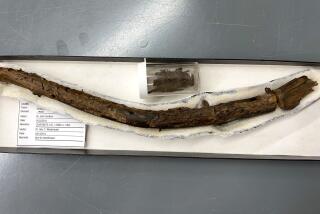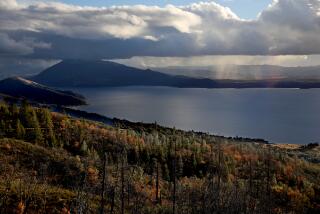Plant Last Seen in 1936 Is Spotted Again
SAN FRANCISCO — On a recent walk in a local state park, apprentice botanist Michael Park spotted a plant that everyone thought was extinct. Now scientific mania over the tiny pink wildflower has quickly reached full bloom.
Park stumbled across Eriogonom truncatum -- a wispy six-inch plant described as a pink version of the baby’s breath used in floral arrangements. The delicate plant, commonly known as the Mount Diablo buckwheat, was last seen in 1936.
In early May, the UC Berkeley graduate student was hiking in a remote section of Mt. Diablo State Park in Contra Costa County. As he looked for new plant species as part of his thesis, he spotted the elusive wildflowers.
“I saw something I didn’t recognize, a little plant with pink puffballs and flower clusters,” he said. “ I got down to plant level, about three to six inches off the ground, and spent several minutes trying to disprove my observations. I went through a list of key characteristics. Then I thought to myself, ‘Oh my goodness, this could be it.’ ”
The 35-year-old Los Angeles native found a dozen examples of a species that had eluded discovery since the Great Depression.
Park, who is pursuing a doctorate in integrative biology, handled himself with aplomb over his find.
“I wanted to run down the mountain immediately and tell everybody,” he said. “But then I figured that might not be the best thing to do.”
His scientific instincts took over, and he finished his research tasks on the mountain.
Experts have compared Park’s find to the recent discovery of the ivory-billed woodpecker in Arkansas, a bird also long thought to be extinct.
“This find is monumental,” said Seth Adams, director of land programs for Save Mount Diablo. “This little wildflower is our own woodpecker. That it has lasted this long is incredible.”
The plant species was originally discovered in the east San Francisco Bay on May 29, 1862, by an agriculture professor named William Brewer, who collected and cataloged the plant and sent specimens back to Harvard and Yale, Adams said.
The buckwheat was last seen in 1936 by Mary Bowerman, who went on to found the preservationist group Save Mount Diablo and published guides to the plants found on the scenic mountain.
For years, scientists and others looking to view the Mount Diablo buckwheat could only view it in pictures and renderings on the Internet or in botanist journals.
Some scientists speculated that the buckwheat might still exist, but no one could prove it. Then Park made his find.
Bowerman, now 97, was in the hospital when she got the news that her plant species was still blooming. “I went to the hospital to let her know,” Adams said. “I thought it would make her very happy.”
Adams said the task at hand is to find out how many of the plants exist in the state park. Other areas where it has been known to grow, such as nearby Antioch, are threatened by development.
“This plant’s future is in a tenuous position,” he said. “But it has managed to survive without our help for the last 70 years. We just hope it can continue.”
Although the exact location of the find is being kept secret, Park returned to the spot Thursday with several botanists to look for other plants.
Park, who once studied to be a physicist, said he left school a few years ago to hitchhike around the country and find a new direction. He said he met numerous “hippies who were into medicinal plants” and returned to Berkeley with a new academic goal: botany.
His find has inspired calls from around the country. Park, who is Korean American, said his parents found out about the discovery when they read about their son in a Korean-language newspaper in Los Angeles.
The aspiring scientist said the little wildflower has taught him a lesson: “It just goes to show you that not everything is known, and not everything can be known.”
The world, he said, is always in flux. “Once you stop looking, it changes.”



